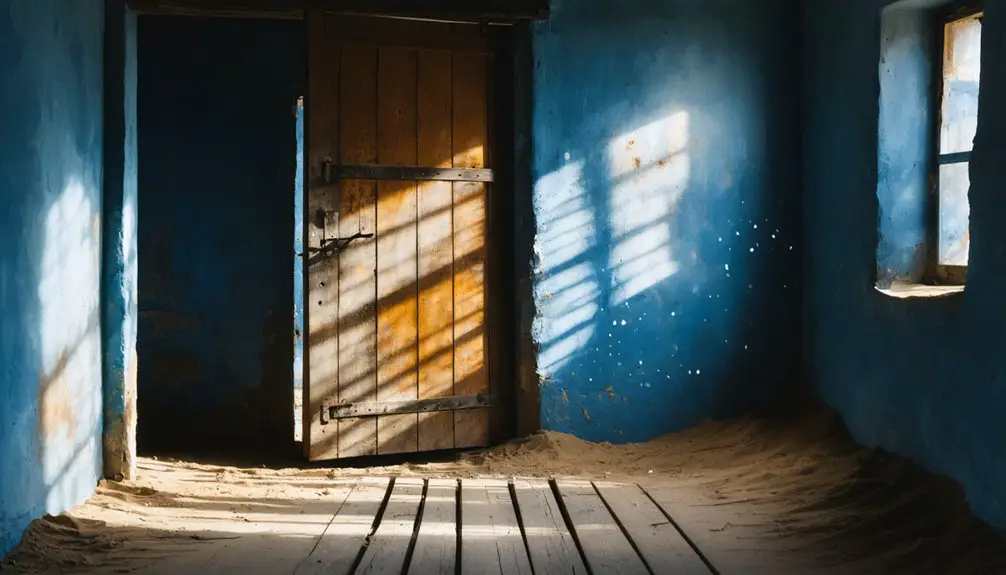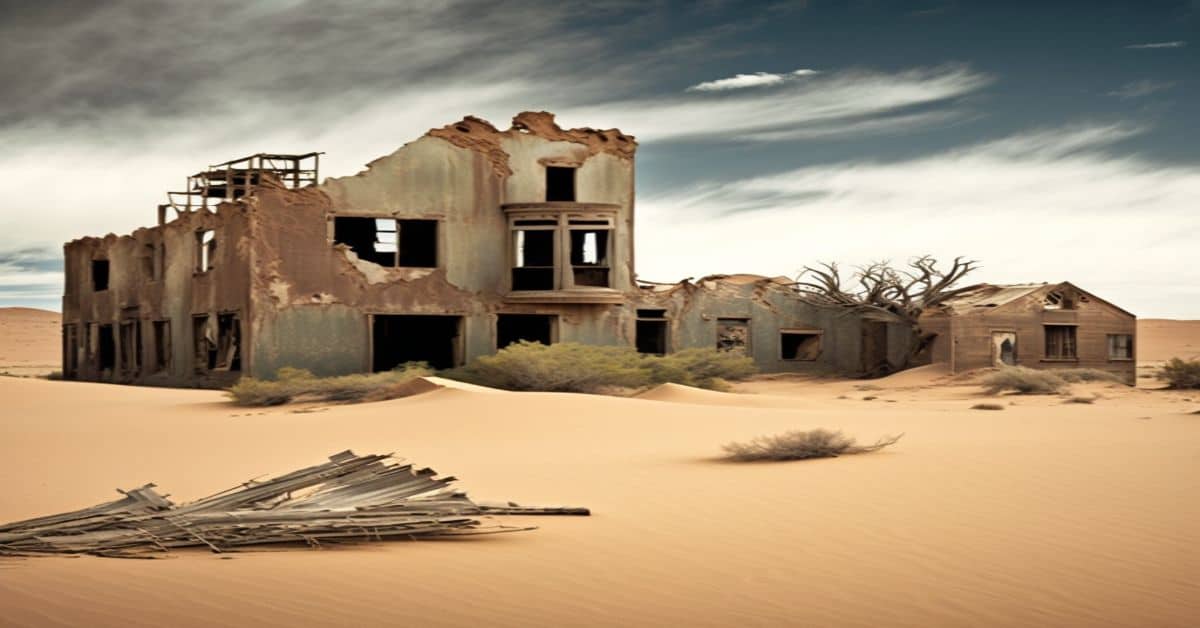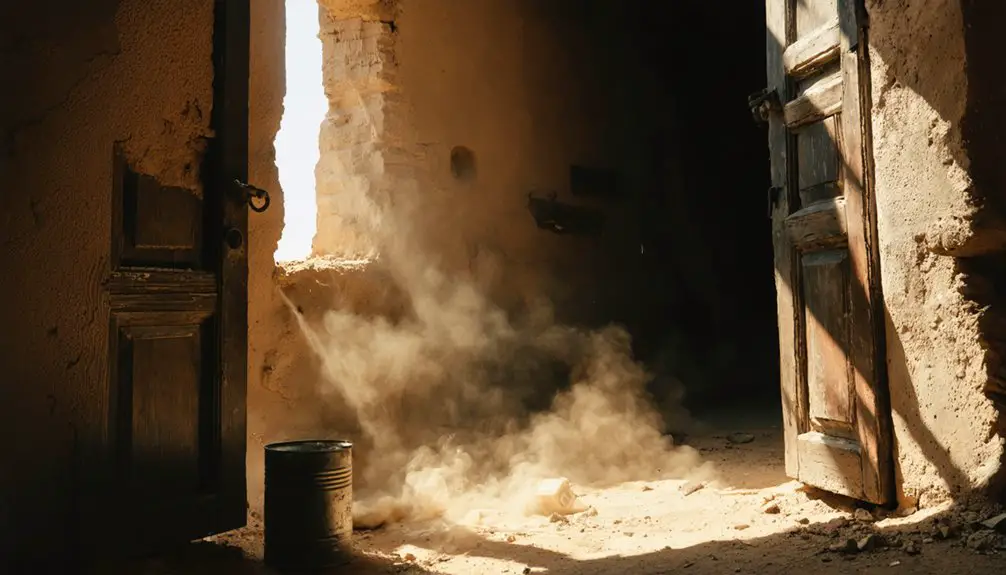Throughout New Mexico’s rugged landscape, you’ll discover over 80 ghost towns that tell haunting tales of the American frontier’s boom-and-bust cycles. From Kingston’s $7 million silver strike to Dawson’s tragic mining disasters, these abandoned settlements showcase crumbling adobe ruins, weathered cemeteries, and remnants of outlaw hideouts. Along former rail lines and in remote mountain valleys, these mysterious towns offer glimpses into an era of prospectors, vigilantes, and frontier justice that shaped the American West.
Key Takeaways
- New Mexico contains over 80 ghost towns featuring abandoned adobe buildings, weathered cemeteries, and remnants of the frontier era.
- Kingston and Lake Valley exemplify silver boom towns that flourished briefly before declining when silver prices crashed in the 1890s.
- The Dawson Cemetery memorializes over 350 miners who perished in mining disasters, marking the dangers of frontier mining life.
- Loma Parda’s ruins preserve stories of its lawless past through abandoned saloons and brothels from the Wild West period.
- White Oaks and Mogollon served as hideouts for notorious outlaws like Billy the Kid and Butch Cassidy.
The Wild West Legacy: Mining Booms and Busts
When silver, gold, and copper were discovered across the American Southwest in the late 1800s, frontier boomtowns emerged virtually overnight.
You’ll find this mining legacy most dramatically in places like Kingston, established in 1882 after a major silver strike, and Lake Valley, where the population exploded to over 4,000 during the silver boom.
Kingston’s rich silver lodes generated an impressive $7 million in mining profits during the 1880s and 1890s.
But these towns lived and died by economic fluctuations.
When silver prices crashed in the 1890s, Lake Valley emptied as quickly as it had filled.
The town of Cerrillos reached such prominence that its turquoise production alone was valued at $1.6 million in 1889.
You can trace similar patterns in Chloride’s silver strikes and Hillsboro’s zinc operations.
Even Elizabethtown, New Mexico’s first incorporated town, couldn’t escape the boom-bust cycle.
While some mines remained productive through World War I, like Hillsboro’s Emerald Zinc operation, most eventually succumbed to depleted ore deposits and falling market prices.
Haunting Remnants: Cemeteries and Adobe Ruins
Two haunting features dominate New Mexico’s ghost towns: crumbling adobe ruins and weathered cemeteries. In places like Montoya and Cuervo, you’ll find deteriorating adobe churches and homes slowly returning to the earth, while historical echoes of frontier life linger in every crack and crevice. The state’s collection of over 80 ghost towns stands as testament to its rich pioneering heritage.
Perhaps nowhere are these remnants more poignant than in Dawson Cemetery, where white iron crosses mark the graves of mining disaster victims. The cemetery expanded after two major disasters that claimed over 350 miners’ lives. You’ll encounter reports of spectral sightings here – mysterious lights resembling miners’ headlamps and full-bodied apparitions that vanish upon approach.
At Loma Parda, once a raucous town of 500 souls near Fort Union, adobe ruins of saloons and brothels tell tales of its lawless past. These sites serve as stark reminders of boom-and-bust cycles that shaped the American West.
Tales of Outlaws and Desert Justice
Throughout New Mexico’s ghost towns, tales of infamous outlaws and frontier justice echo across abandoned streets and crumbling buildings.
You’ll find outlaw legends in White Oaks, where Billy the Kid‘s gang clashed with local posses, and in Mogollon, where Butch Cassidy found refuge among the mining claims. Many of these towns experienced dramatic boom and bust cycles that attracted both fortune seekers and criminals.
In Eureka, counterfeiters and cattle rustlers operated brazenly, trafficking stolen goods across the Mexican border while dodging Wells Fargo bounty hunters. The notorious Madame Varnish’s saloon became a den where countless miners gambled away their fortunes from the local gold mines.
Vigilante justice prevailed when law enforcement proved insufficient, with townspeople taking matters into their own hands.
Even Columbus witnessed its share of violence during Pancho Villa’s 1916 raid, the only foreign invasion of U.S. soil in the 20th century.
These ghost towns stand as evidence to an era when desert justice ruled the untamed frontier.
Life Along the Rails: Railroad Ghost Towns
As steam locomotives thundered across New Mexico’s stark landscapes, they gave birth to numerous towns that would ultimately share the same fate of abandonment.
Through harsh desert terrain, iron horses forged frontier settlements destined to fade into dusty memory and ruin.
You’ll find their haunting remains scattered along the old Denver & Rio Grande Railroad routes, where towns like Dawson and Koehler once flourished as essential coal mining hubs.
Railroad history comes alive in places like Duran, where a wooden roundhouse served the El Paso & Northeastern’s Arrow Route, and water wells sustained countless work crews. Much like White Oaks, which saw its demise when the railroad bypassed town, these settlements were at the mercy of transportation decisions. The town of Playas met a similar end when copper prices declined in 1999, forcing its smelter to close.
For ghost town exploration enthusiasts, these forgotten settlements offer poignant testimonials to boom-and-bust cycles.
The iron crosses of Dawson’s cemetery stand as silent sentinels to mining disasters, while Koehler’s industrial ruins beckon off-road adventurers.
Each abandoned depot and crumbling foundation tells a story of ambition, prosperity, and ultimate surrender to changing times.
Hidden Treasures: Remote Mountain Communities
High in New Mexico’s rugged mountains, remote colonial settlements reveal fascinating stories of survival and cultural fusion. You’ll find these communities, like Santa Rosa de Lima de Abiquiú, built atop ancient Pueblo ruins, serving as strategic buffers against tribal raids while fostering a unique cultural heritage through their mission churches adorned with native santos.
The towns’ resilience emerged through innovative water management, with community-operated acequias sustaining agriculture in harsh conditions. Along the Rio Chama valley, Abiquiú’s narrow landscape showcases the stark beauty of red hills against lush green fields. The region’s current population of over 17,000 residents represents dramatic growth from its humble beginnings.
While many settlements began as mining ventures, they’ve evolved beyond their industrial roots, demonstrating remarkable community resilience. Despite geographic isolation that limited contact during winter months, these mountain dwellers maintained their independence through self-governance and cooperative resource management.
Today, these hidden treasures stand as symbols of the enduring spirit of New Mexico’s mountain pioneers.
Frequently Asked Questions
Are Any New Mexico Ghost Towns Inhabited by Caretakers Year-Round?
You’d think ghost towns are completely deserted, but caretaker stories reveal year-round inhabitants in places like Trementina and Handover, where fewer than 30 people maintain these historic New Mexico sites.
What Survival Gear Is Essential for Safely Exploring Remote Ghost Towns?
You’ll need reliable navigation tools to prevent getting lost, an all-encompassing first aid kit, sturdy boots, protective gloves, purified water, emergency shelter, and proper clothing for harsh conditions.
Can Visitors Legally Remove Artifacts Found in Ghost Town Ruins?
You can’t legally remove artifacts from ghost towns – it’s prohibited by federal law. You’ll face serious legal consequences and harm artifact preservation efforts. Take photos instead of disturbing historical sites.
Which Ghost Towns Are Accessible During Winter Months?
You’ll find winter exploration easiest at low-elevation sites like Cuervo and Glenrio along I-40, while Mogollon and Jemez Mountain ghost towns offer seasonal accessibility between snowstorms with proper vehicle preparation.
Do Any Ghost Towns Still Hold Religious or Cultural Ceremonies?
You’ll find active religious ceremonies at San Francisco de Asis Church in Golden, while Cerillos maintains cultural heritage events. Some ghost towns serve as gathering places of spiritual significance for indigenous communities.
References
- https://newmexicotravelguy.com/new-mexico-ghost-towns/
- https://www.atlasobscura.com/things-to-do/new-mexico/ghost-towns
- https://compaslife.com/blogs/journal/abandoned-enchantment-ghost-towns-of-new-mexico-1
- https://en.wikipedia.org/wiki/List_of_ghost_towns_in_New_Mexico
- https://geronimoranch.com/blog/ghost-towns-in-nm/
- https://newmexiconomad.com/kingston/
- https://www.santafe.org/blog/post/historic_cerrillos/
- https://www.newmexico.org/places-to-visit/ghost-towns/
- https://www.youtube.com/watch?v=ICa5i0napuw
- https://usghostadventures.com/haunted-places/dawson-ghost-town-and-cemetery/



